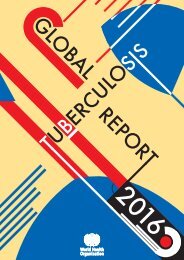patients
DNDi_AR_2015
DNDi_AR_2015
Create successful ePaper yourself
Turn your PDF publications into a flip-book with our unique Google optimized e-Paper software.
R&D MODEL & PORTFOLIO<br />
FILARIAL DISEASES<br />
What are the current treatments and their limitations?<br />
Current treatments for onchocerciasis and lymphatic filariasis are based on repeated mass<br />
drug administration (MDA) of antiparasitic drugs through programmes directed by the WHO.<br />
WHO recommends MDA for onchocerciasis at least once yearly for 10-15 years, and for<br />
lymphatic filariasis once yearly for at least five years. The drugs used in MDA programmes<br />
are ivermectin for onchocerciasis; albendazole for lymphatic filariasis; and albendazole plus<br />
either ivermectin in areas where onchocerciasis is also endemic (i.e. African countries), or<br />
diethylcarbamazine (DEC) in areas where onchocerciasis is not co-endemic (i.e. non-African<br />
countries).<br />
A bite from an infected insect allows filarial larvae to pass into the blood and migrate through<br />
the human body. These mature into adults that produce microfilariae, which the insect<br />
ingests during a blood meal, and the cycle goes on. MDA drugs can prevent this vector-borne<br />
transmission for several months by killing mainly the microfilariae, and inducing a temporary<br />
sterilization of adult worms. However, because adult worms (macrofilariae) continue to live<br />
in the body, they eventually produce new microfilariae, often before the next MDA, thus<br />
requiring repeated MDAs for several years to decades.<br />
Ivermectin treatment is safe and has<br />
been used widely in MDA programmes.<br />
However, the use of ivermectin in <strong>patients</strong><br />
co-infected with high levels of Loa loa<br />
microfilaria in the blood can result in<br />
safety issues such as the occurrence of<br />
encephalopathy that can be fatal if not<br />
properly managed. Additionally, a suboptimal<br />
response to ivermectin in <strong>patients</strong><br />
with onchocerciasis has been reported<br />
which may be a sign of resistance development.<br />
Furthermore, the morbidity<br />
associated with onchocerciasis and LF<br />
infection (itching, dermatitis, lymphedema,<br />
and blindness) are only partially<br />
improved or prevented and require repeated<br />
treatment with the current drugs.<br />
ONCHOCERCIASIS<br />
37 million<br />
infected worldwide,<br />
with 99% cases in<br />
31 African<br />
countries<br />
746,000<br />
visually impaired<br />
265,000 blinded<br />
and more than 4 million<br />
suffering from severe itching<br />
169 million<br />
were estimated<br />
at risk in 2014<br />
LYMPHATIC<br />
FILARIASIS<br />
Over 1.1 billion<br />
people at risk worldwide,<br />
57% in South East Asia<br />
region<br />
Over 36 million<br />
suffering from clinical illness<br />
(19.4 million with<br />
hydrocele, and 16.6 million<br />
with lymphedema)<br />
WHAT IS DNDi DOING TO ADDRESS UNMET TREATMENT NEEDS?<br />
DNDi’s strategy is to develop a new<br />
compound with macrofilaricide activity<br />
(to kill adult worms) for use as a safe<br />
and field-adapted macrofilaricidal drug<br />
for patient case management and possibly<br />
later MDA if needed.<br />
As a medium-term strategy, DNDi is<br />
assessing emodepside which is<br />
commercialized by Bayer under license<br />
from Astellas as an anthelmintic<br />
veterinary drug for cats and dogs in<br />
combination with praziquantel<br />
(Profender ® ) and in combination<br />
with toltrazuril (Procox ® ). DNDi has<br />
an agreement with Bayer to develop<br />
emodepside for the treatment of<br />
onchocerciasis.<br />
Other compounds targeting Wolbachia,<br />
a worm symbiotic bacteria present in the<br />
parasites causing onchocerciasis and LF,<br />
will also be explored.<br />
As a long-term strategy, DNDi is<br />
assessing additional opportunities through<br />
an active screening programme of drug<br />
compounds emanating from animal<br />
health/pharmaceutical companies and<br />
academic institutions, with the goal of<br />
selecting one or two candidates to move<br />
into clinical development.<br />
DNDi aims to deliver a safe, efficacious,<br />
affordable, and field-adapted<br />
macrofilaricidal drug for onchocerciasis<br />
and/or lymphatic filariasis for the<br />
treatment of <strong>patients</strong>, and as a possible<br />
alternative in mass drug administration<br />
programmes.<br />
42 › DNDi Annual Report 2015



